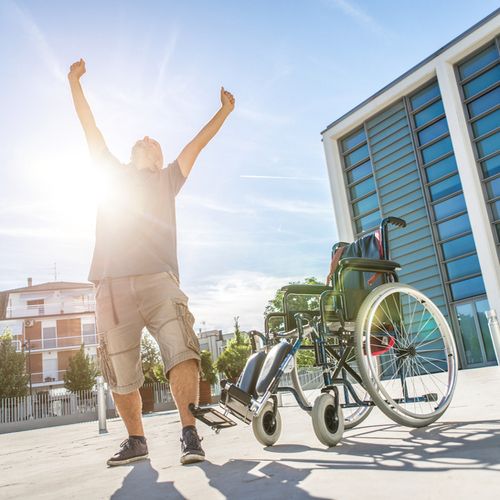Virtual Physical Therapy: Delivering Musculoskeletal Rehabilitation Remotely
Let’s face it, life is busy! Between work, family, and that ever-growing pile of laundry, finding time to commute to a physical therapy clinic can feel like a Herculean task. And when you’re dealing with a nagging backache, a tricky knee, or a shoulder that just won’t cooperate, the thought of adding another appointment to your calendar can be downright deflating.
But what if your physical therapist could come to you? Not literally, of course – we’re good, but we haven’t mastered teleportation yet! We’re talking about telerehabilitation, a game-changer in healthcare that leverages technology to deliver essential rehabilitation services remotely. It’s like having a rehabilitation clinic in your pocket, or more accurately, on your screen. Telerehabilitation plays a pivotal role in making healthcare more accessible and convenient, especially for those in remote areas, with mobility challenges, or simply with jam-packed schedules. It ensures continuity of care, empowering you to stay consistent with your recovery journey from the comfort and safety of your own home.
The Rise of Virtual Physical Therapy for Musculoskeletal Marvels
Specifically, when it comes to musculoskeletal rehabilitation – that’s all those wonderful bones, muscles, ligaments, and tendons that keep us moving – virtual physical therapy (VPT) is proving to be a true superhero. Whether you’re recovering from a sports injury, dealing with chronic back pain, or getting back on your feet after surgery, VPT offers a flexible, effective, and often more convenient alternative to traditional in-person sessions.
Imagine this: You wake up with a stiff neck. Instead of calling around, trying to squeeze into a clinic’s schedule, and battling rush hour, you simply log into a secure platform. Your physical therapist appears on your screen, ready to assess your movement, guide you through specific exercises, and provide real-time feedback – all while you’re wearing your most comfortable sweatpants. It’s truly revolutionary!
How Does It Work? No Magic Wands, Just Smart Tech!
Virtual physical therapy isn’t just a video call; it’s a comprehensive approach that often integrates various technologies to replicate and even enhance the in-clinic experience:
- Live Video Consultations: These are the heart of VPT. You connect with your licensed physical therapist via secure video conferencing. They can visually assess your movement patterns, posture, and technique as you perform exercises, just as they would in person. Think of it as a virtual “mirror” for your therapist!
- Guided Exercise Programs: Your therapist designs a personalized exercise plan tailored to your specific condition and goals. These programs often include instructional videos, detailed descriptions, and even printable guides to ensure you’re performing exercises correctly between sessions.
- Wearable Sensors & Apps: Many advanced platforms incorporate wearable sensors that track your movement, range of motion, and even the quality of your exercises. This data is then shared with your therapist, allowing for objective progress monitoring and real-time adjustments to your program. No more guessing if you’re doing that squat right!
- Educational Resources: Understanding your condition is key to recovery. VPT often includes access to a wealth of educational materials, helping you learn about your body, injury prevention, and self-management strategies.
The Benefits: Why Your Body (and Schedule) Will Thank You
The advantages of embracing virtual physical therapy for musculoskeletal issues are plentiful:
- Convenience is King (or Queen!): No travel time, no parking woes, no rearranging your entire day. Therapy fits into your schedule, whether it’s during your lunch break or after the kids are in bed.
- Enhanced Accessibility: Living in a rural area? Mobility issues making travel difficult? VPT breaks down geographical barriers, ensuring you can access specialized care no matter where you are.
- Consistency is Key: When therapy is easy to access, you’re more likely to stick with it. Regular, consistent engagement often leads to faster and more effective recovery.
- Comfort and Privacy: Recover in the environment you feel most at ease – your home! This can reduce anxiety and help you focus on your exercises.
- Cost-Effective: By cutting out travel expenses and potentially reducing the total number of sessions needed due to improved adherence, VPT can be a more budget-friendly option.
- Personalized Attention: While it’s virtual, the interaction is still highly personalized. Your therapist is dedicated to your progress, offering individualized guidance and support.
So, if you’re grappling with a musculoskeletal issue and looking for a rehabilitation solution that fits into your modern life, it’s time to explore the world of virtual physical therapy. Ditch the commute, embrace the convenience, and get back to doing what you love, faster! Your future, healthier self will thank you.
Understanding the Limitations: When In-Person Might Still Be Best
While virtual physical therapy offers incredible advantages, it’s important to recognize that it’s not a one-size-fits-all solution. There are some inherent limitations when it comes to musculoskeletal conditions that might require an in-person visit. A key constraint is the lack of access to specialized physiotherapy equipment that’s often crucial for precise assessment or advanced therapeutic techniques. Devices like traction machines, high-intensity laser therapy units, specific electrotherapy modalities, or advanced robotic rehabilitation tools are simply not available for home use.
Therefore, it’s vital to understand that while virtual physical therapy is a powerful and efficient tool, it doesn’t entirely replace all aspects of traditional in-person treatment. If your physical therapist determines that your specific condition requires the use of specialized equipment, hands-on manipulations, deep tissue massage, or particular tactile assessment techniques only available in a clinic setting, an in-person referral will be necessary. Your therapist will always guide you on the most effective course of treatment, ensuring you receive the best possible care for your unique needs.





